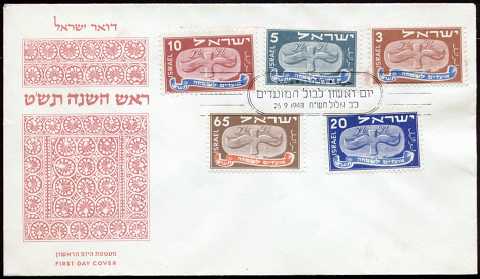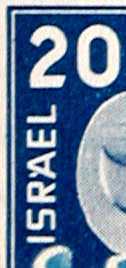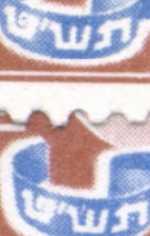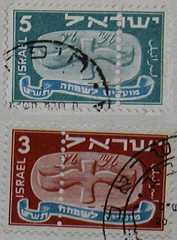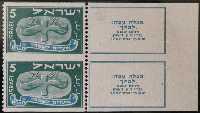BIBLIOGRAPHY:
Each listing contains at least one photo of a LMLK stamp, or some significant textual content.
"Archaeology, Stamps and Coins of the State of Israel" by Yitzhak Zahavy, 31 December 2009 (color photo of stamps & handles on cover; LMLK content on pp. 2 & 29)
ASOR Blog: "On Shopping for Artifacts in the Holy Land: A Response to Morag M. Kersel" by G.M. Grena, 9 April 2012 (color photo of postally used FDC with misoriented 65m stamp)
British Association of Palestine-Israel Philatelists Bulletin
- BAPIP Bulletin #5, July 1953, p. 20; "Photo-Offset In Israel" by Frank A. Read (reprinted from The Penrose Annual vol. 44, 1950, p. 139)
- BAPIP Bulletin #13, July 1955, p. 22; "The Flying Scroll" by S.N. Shure
Catalogs:
- "A Century of Jewish History" by Victor H. Bernstein
- "Catalogue of Israel Postage Stamps" by Michael H. Bale
- "Israel Postage Stamps" by Yacov Tsachor
- "Israel Stamps Catalogue" by Yehuda Hugo Kolar
- "Israel Stamps Catalogue" by Carmel
- "Krause-Minkus Standard Catalog of Israel Stamps" by Maurice D. Wozniak
- "Mosden Israel Catalogue" by E.H. Moshi, Louis S. Schulman, & Leon Walters
- "Simon's Catalogue of Israel Stamps" by Isidore Simon
Doar Ivri (Revue du Cercle Francais Philatelique d'Israel):
- DI #2, Janvier-Avril 2005; p. 31, "Personnaliser sa collection d'Israel" by R. Livnat (photo of 65m tete-beche set with pane# triangles)
- DI #9, Mai-Aout 2007; pp. 179 (cover) & 188-9, "Tirage de la Serie 'Nouvel An 1948'" by Jean-Paul Danon
- DI #10, Septembre-Decembre 2007; p. 212, "Les Camps de refugies a Chypre" by Jean-Paul Danon; p. 219, "Tirage de la Serie 'Nouvel An 1948' (suite)" by Jean-Paul Danon
- DI #11, Janvier-Avril 2008; pp. 1 (cover) & 5-7, "Deux Varietes du Rouleau Volant: Le Mystere Mosden" by G.M. Grena
- DI #12, Mai-Aout 2008; p. 22, "Le courrier des lecteurs: Les Varietes du Rouleau Volant" by Jean Richard Callebaut & G.M. Grena
- DI #17, Septembre-Decembre 2009; p. 17, "Obliterations Triangulaires du Nouvel An" by Jean-Paul Danon
- DI #18, Janvier-Avril 2010; p. 25, "Nouvel An 5709, Une Variete Spectaculaire" by Jean-Paul Danon
- DI #19, Mai-Aout 2010; p. 13, "Mai 1948 - decembre 1949 ; retablissement des relations postales" by Richard S. Herman
- DI #21, Janvier-Avril 2011; pp. 20-3, 28, "Nouvel An 1948 : les Rouleaux volants" by Jean-Paul Danon
Gibbons-Whitman Stamp Monthly vol. 1, #7, March 1968, pp. 237, 239, 242; "The Festival Stamps of Israel" by Bruno J. Forsher
The Holy Land Philatelist: Israel's Stamp Monthly (published from Nov. 1954 - Sep. 1961):
- HLP vol. 1, #8, June 1955, p. 223; "Israel Varieties" by Eduard Weich
- HLP vol. 1, #9/10, Jul-Aug 1955, p. 247; "Stamps With Tabs" by L.N. & M. Williams
- HLP vol. 1, #11, September 1955, p. 275; "About the Flying Scroll" by F.W. Pollack (abridged from BAPIP #13)
- HLP vol. 2, #14, December 1955, p. 358; "More About the Cyprus Detention Camps" by A.H. Jarmain
- HLP vol. 3, #35/36, Sep-Oct 1957, p. 779; "Stamp Exhibitions in Israel" by F.W. Pollack
- HLP vol. 4, #42, April 1958, p. 952; "Postal History Mail Auction No. 8" by F.W. Pollack
Israel-Palestine Philatelist (journal of the Society of Israel Philatelists):
- IPP vol. 1, #7, May 1950, p. 54; "Official Issues" (by editorial board)
- IPP vol. 3, #5, January 1952, p. 46; "Dates of Invalidation" by Louis A. Sarrow
- IPP vol. 4, #10, June 1953, pp. 93-4; "The Flying Scroll" by Louis Schulman-Irving Weisberger
- IPP vol. 9, #1, September 1957, p. 4; "Ancient Jewish Seals on Israeli Stamps" by Emil Weitz
- IPP vol. 9, #10, June 1958, p. 140; "Biblical Motives on Israeli Stamps" by Emil Weitz
The Israel Philatelist (same journal of the Society of Israel Philatelists; name changed on vol. 11, #1):
- TIP vol. 12, #3, November 1960, p. 338; "How to Collect the Postmarks of Israel" by E. Rachwalsky & B. Remington
- TIP vol. 13, #6, February 1962, p. 641; "Art on Israel Stamps" by Alexander S. Kohanski
- TIP vol. 15, #8, May-June 1965, p. 1371; "The 1948 Festival Stamps - A Puzzle" by Sam Aaron
- TIP vol. 17, #3-4, Nov-Dec 1965, pp. 1478 & 1483; letters to the editor with 1948 Festival pane numbers by Charles Potter, Walter J. Stern, Major S. Denfield
- TIP vol. 17, #11-12, Jul-Aug 1966, p. 1674; letter to the editor with 1948 Festival slug positions by Major S. Denfield
- TIP vol. 18, #1-2, Sept-Oct 1966, p. 1693; "The Israel Festival Stamps, 1948-1965" by Alexander S. Kohanski
- TIP vol. 20, #9-10, June 1969, p. 220; "Israel Triangular Festival Cancellations" by David J. Simmons
- TIP vol. 20, #9-10, June 1969, pp. 232-3; "The 1948 Festival Issue: First & Second Printing" by H. Jeidel
- TIP vol. 21, #7-8, April 1970, pp. 128-9; "The Tete-Beche Issues of Israel--A Survey" by Oscar Stadtler
- TIP vol. 21, #11-12, August 1970, pp. 210, 220-1; "Basic Israel Philately" by David J. Simmons
- TIP vol. 22, #3-4, December 1970, pp. 72-3; "Tete-Beche on First Day Covers" by Max M. Manning
- TIP vol. 23, #7-8, April 1972, p. 188; "Printing" by M. Madesker
- TIP vol. 24, #11-12, August 1973, pp. 275, 278-9; "The Production of the First Israel Stamps" by Frank E. Read
- TIP vol. 24, #13-14, October 1973, pp. 345-6; "Album Leaves: Festival Stamps 1948" by Arthur Cohen
- TIP vol. 25, #9/10, October 1974, p. 642; "Israel Plate Blocks of Six" by Ezra Berkowitz
- TIP vol. 26, #5/6, June 1975, p. 843; "Errors and Varieties" by Albert Friedberg
- TIP vol. 29, #3/4, April 1978, pp. 1573-5; "The 1948 Festival Issue: 65 Pruta First & Second Printings" by William D. Farber
- TIP vol. 30, #1/2, February 1979, pp. 1824-8; "The 1948 Festival (Flying Scroll) Issue: 3 Pruta Second Printing Revised" by William D. Farber
- TIP vol. 31, #1/2, February 1980, pp. 2131-3; "Notes on the 1948 Festival Issue; The Flying Scrolls" by William D. Farber
- TIP vol. 32, #1/2, February 1981, pp. 2411-7; "Printing the 1948 Festival (Flying Scroll) Issue: Part 1" by William D. Farber
- TIP vol. 32, #3/4, April 1981, pp. 2487-97; "Printing the 1948 Festival (Flying Scroll) Issue: Part 2" by William D. Farber
- TIP vol. 32, #5/6, June 1981, pp. 2548-55; "Printing the 1948 Festival (Flying Scroll) Issue: Part 3" by William D. Farber
- TIP vol. 34, #1/2, February 1983, pp. 3018-24; "Nature & Origin of the Flying Scroll Design" by William D. Farber
- TIP vol. 57, #3, June 2006, pp. 100-3; "Part 1 (Flying Scroll) Digging Deeper into the 1948 Festival Stamps" by G.M. Grena
- TIP vol. 57, #6, December 2006, pp. 208-10; "Part 2 (Flying Scroll) Digging Deeper into the 1948 Festival Stamps" by G.M. Grena
- TIP vol. 58 [note--the cover erroneously says "LIII" instead of "LVIII"], #3, June 2007, pp. 110-2; "Part 3 (Flying Scroll) Digging Deeper into the 1948 Festival Stamps" by G.M. Grena
- TIP vol. 58, #5, October 2007, pp. 190-2; "Part 4 (Flying Scroll) Digging Deeper into the 1948 Festival Stamps" by G.M. Grena
- TIP vol. 59, #1/2, Feb-Apr 2008, p. 8; "Letters to the Editor" by Allen H. Simon
- TIP vol. 59, #5, October 2008, pp. 190, 198; "Part 3 - Fakes and Forgeries" by Yacov Tsachor
- TIP vol. 62, #3, June 2011, p. 89; "Exhibiting at National Stamp Shows" by Richard (Dick) Herman

"So the posts went with the letters from the king & his princes throughout all Israel & Judah."--2Chronicles 30:6
|



